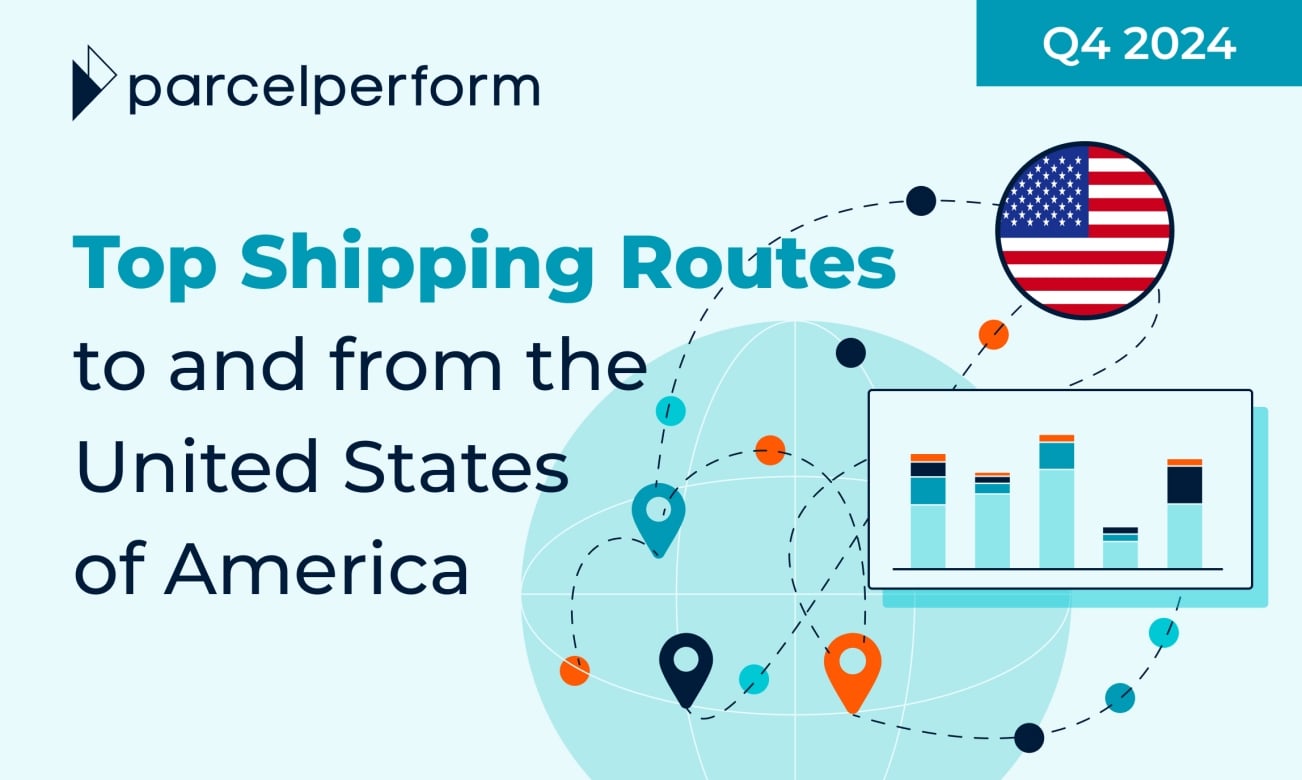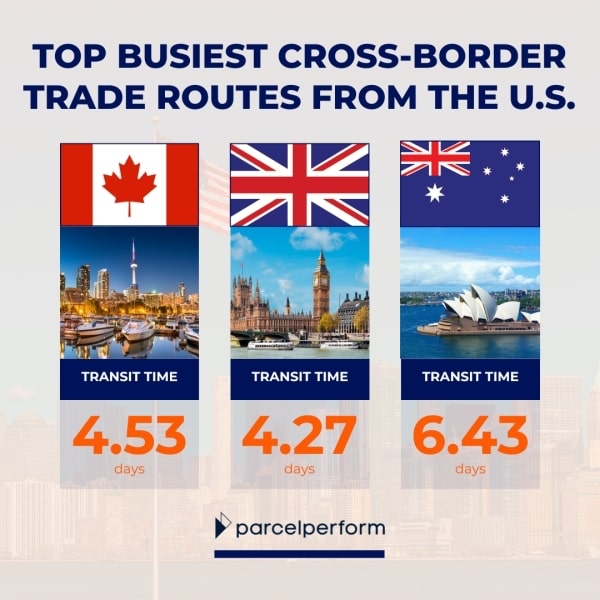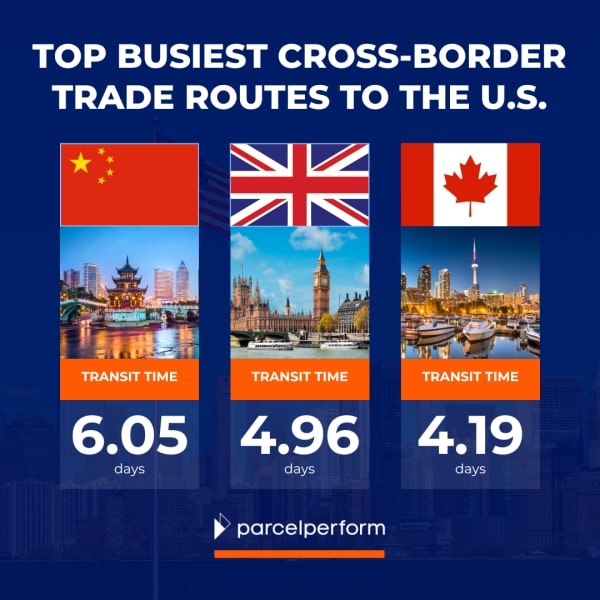Top shipping routes to and from the United States of America in Q4 2024
Written by
Editorial TeamPublished on
Explore key US shipping routes in Q4 2024, logistics challenges, and strategies to improve cross-border e-commerce efficiency. (Ad)

(Source: Parcel Perform)
Commercial collaboration
The cross-border e-commerce industry now accounts for around 31.2% of global online sales. The market was valued at USD 2,830.7 billion in 2023 and is expected to increase at a CAGR of 24.9% between 2024 and 2030. The rapid development of online shopping, cross-border commerce, and advances in logistics technology have all contributed to the market’s growth. Furthermore, the growing number of online consumers, the expansion of e-commerce platforms, and the increase of mobile commerce are expected to propel the industry forward.
Notably, the United States is a prominent player in global e-commerce, connecting the Americas to the rest of the globe. With yearly online sales of USD 1.22 trillion, it is the largest e-commerce market in the Americas and the second largest internationally, behind China. This extraordinary position emphasizes the significance of efficient and dependable logistics in sustaining the ongoing rise of cross-border e-commerce.
With that in mind, Parcel Perform analyzes some of the key shipping routes to and from the US, identifying logistics providers’ challenges and discussing potential solutions. The article also explores primary performance metrics such as delivery success ratio, transit time, carrier issue ratio, and on-time delivery ratio to offer an in-depth view of the efficiency and reliability of these vital trade corridors. Through these insights, Parcel Perform aims to help e-commerce businesses optimize their logistics strategies and enhance cross-border e-commerce operations.

Outbound trade: Key shipping routes from the United States
The US is a central global trade hub, with outbound shipping routes connecting North America to key markets across Asia, Europe, and beyond. Understanding these trade corridors is essential for businesses looking to optimize their international shipping operations.
United States to Canada (US-CA)
In 2024, US exports to Canada were $348.41 billion, making it one of the top trade partners for the US. Given the short distance, the average transit time of 4.53 days in Q4 2024 was outstanding, demonstrating the efficiency of carriers operating on the US-CA corridor. The on-time delivery ratio of 89.19% while the first-attempt delivery success ratio of 83.52% indicated a potential for improvement. Furthermore, the collection point use ratio was 8.64%, showing the adoption of alternative delivery methods, like pick-up points, to improve convenience.
However, the shipments between the two nations have strained logistical networks, causing customs and border clearance process delays. Weather conditions, particularly in the winter, have caused disruptions in transportation schedules.
Businesses may solve these difficulties by implementing sophisticated forecasting tools and streamlining customs processes. Providing flexible delivery alternatives and leveraging technology can also increase communication and cooperation between carriers and stakeholders, eventually improving overall logistics performance.
United States to United Kingdom (US-GB)
US exports to the UK reached $79.89 billion in 2024. The average transit time of 4.27 days obtained in Q4 2024 was impressive, demonstrating the efficiency of logistics operations. Besides, the on-time delivery ratio of 95.12% showed the route’s dependability, yet the first-attempt delivery success percentage of 86.83% indicated areas for development. The carrier problem ratio of 7.3% suggested some issues with carrier performance.
However, the US-GB trade route confronts several logistical hurdles. The complexity of customs clearance processes and carrier performance inconsistencies have resulted in delays and hampered delivery success. Brexit restrictions have also influenced cross-border logistics efficiency.
To address these challenges, real-time tracking of carrier performance, expediting customs processes, and efficient last-mile delivery technologies should be employed. Furthermore, staying informed on legislative changes and modifying logistical strategies might assist in handling Brexit uncertainty.
United States to Australia (US-AU)
The US exported $34.6 billion worth of goods to Australia in 2024, with an average transit time of 6.43 days in Q4. The on-time delivery ratio of 93.86% demonstrated consistent performance, although the first-attempt delivery success ratio of 88.91% indicated considerable areas for improvement. Also, the carrier issue ratio of 5.92% emphasized the difficulty of maintaining continuous carrier performance over such a lengthy distance.
Despite the exceptional achievements, the considerable distance between Australia and the US resulted in longer delivery times and delays due to customs and regulatory requirements. Furthermore, Australia’s transportation infrastructure and geographical limitations impacted last-mile delivery efficiency.
Thus, improving routes and schedules, utilizing technology to comply with customs requirements, real-time tracking, and collaborating with local partners may increase delivery efficiency.
Inbound trade: Key shipping routes to the United States
The US is one of the world’s largest import markets, relying on well-established inbound shipping routes from Asia, Europe, and other global regions. These trade corridors are vital for maintaining steady supply chains and meeting consumer demand. However, each route has its own logistics challenges that require careful attention and practical solutions.

China to United States (CN-US)
In 2024, the US imported $462.62 billion from China. During Q4, the average transit time for shipments from China to the US was 6.05 days. The on-time delivery ratio was 76.18%, while the first-attempt delivery success rate was 84.74%. Additionally, the carrier issue ratio was quite low, at 2.2%.
Due to customs clearance delays and port congestion, the trade route from China to the US confronts difficulties in managing large volumes of commodities. Businesses may utilize advanced logistics analytics to predict demand and manage shipment schedules, increasing efficiency. Digital paperwork and pre-clearance can also help simplify customs processes, while real-time tracking technologies can help monitor shipments and handle concerns quickly. These solutions may all result in smoother operations and higher delivery performance.
United Kingdom to United States (UK-US)
In Q4 2024, the average transit time for goods from the UK to the US was 4.96 days. The on-time delivery ratio was 85.85%, with a carrier issue ratio of 3.69%. Generally, the UK-US trade route was relatively efficient, yet specific issues must be overcome.
Regarding the UK-US trade route, navigating customs clearance processes frequently resulted in delays, lowering the on-time delivery rate. Not to mention, carrier performance difficulties provided further hurdles, compromising delivery dependability.
Improving carrier performance monitoring using real-time data can help address these challenges. Meanwhile, improving customs procedures, such as electronic paperwork and pre-clearance, can help to cut delays.
Australia to United States (AU-US)
During Q4 2024, the average transit time for goods from Australia to the US was 5.77 days. Although the on-time delivery ratio was 93.86%, the carrier problem ratio was relatively high at 6.74%. These indicators show that this route is reliable; however, there are still some logistics challenges.
Similar to the US-AU trade route, the long distance between Australia and the US resulted in longer delivery times. Besides, navigating various customs regulations and maintaining compliance led to delays.
To improve carrier dependability, businesses, and logistics providers should undertake extensive performance evaluations, quickly resolve service irregularities, and use digital platforms for easy customs compliance. Furthermore, frequent delivery updates and flexible scheduling choices can help improve logistical efficiency and customer satisfaction.
New tariffs affecting Chinese marketplaces: Implications for cross-border trade
On March 4, 2025, President Donald Trump raised the tariff on all products imported from China from 10% to 20%. The additional 10% tariff on all Chinese goods is projected to increase the costs American customers pay for a wide range of items, from low-cost clothes offered online shopping platforms to toys and electronic devices like computers and cell phones.
These recent changes have posed considerable hurdles for Chinese markets like Amazon Haul and Shein. Companies frequently pay these tariffs and taxes when importing products. Nevertheless, the ultimate customers will bear the additional expenses through increased pricing.
In addition, this tariff update has substantial implications for cross-border trade. These new tariffs can impact the cost and speed of cross-border shipping from China to the US. With the greater price being passed down to consumers, there could be a decline in demand for Chinese goods. As a result, this could result in fewer shipments and longer transit times since carriers adjust their operations.
In such circumstances, businesses that rely on Chinese imports must find ways to streamline logistics and cut costs more than ever to remain competitive in the market. Fortunately, they may address these difficulties more successfully by leveraging technology and improving shipping routes.
Closing thoughts
Overall, Parcel Perform’s analysis of significant shipping routes to and from the US in Q4 2024 offered relevant facts about the efficiency and dependability of major global commerce corridors. The findings emphasize the importance of data-driven decision-making in optimizing cross-border e-commerce logistics. Businesses using advanced analytics, real-time shipment tracking, and more efficient customs-clearing processes may improve transit times, minimize carrier difficulties, and increase delivery rates.
Furthermore, Parcel Perform encourages e-commerce retailers and logistics providers to regularly evaluate performance data and adjust their methods to remain competitive and satisfy growing customer expectations in global markets.
***


